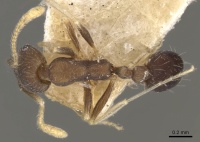Monomorium wroughtoni
| Monomorium wroughtoni | |
|---|---|

| |
| Scientific classification | |
| Kingdom: | Animalia |
| Phylum: | Arthropoda |
| Class: | Insecta |
| Order: | Hymenoptera |
| Family: | Formicidae |
| Subfamily: | Myrmicinae |
| Tribe: | Solenopsidini |
| Genus: | Monomorium |
| Species: | M. wroughtoni |
| Binomial name | |
| Monomorium wroughtoni Forel, 1902 | |
Identification
Bolton (1987) - A member of the M. pharaonis complex in the M. salomonis species group.
Distribution
Distribution based on Regional Taxon Lists
Oriental Region: India (type locality).
Distribution based on AntMaps
Distribution based on AntWeb specimens
Check data from AntWeb
Countries Occupied
| Number of countries occupied by this species based on AntWiki Regional Taxon Lists. In general, fewer countries occupied indicates a narrower range, while more countries indicates a more widespread species. |

|
Estimated Abundance
| Relative abundance based on number of AntMaps records per species (this species within the purple bar). Fewer records (to the left) indicates a less abundant/encountered species while more records (to the right) indicates more abundant/encountered species. |

|
Biology
Castes
Nomenclature
The following information is derived from Barry Bolton's Online Catalogue of the Ants of the World.
- wroughtoni. Monomorium wroughtoni Forel, 1902c: 209 (w.) INDIA (Maharashtra, Karnataka).
- Type-material: syntype workers (number not stated).
- Type-localities: India: Poona (Wroughton), Kanara (Wroughton).
- Type-depository: MHNG.
- Status as species: Forel, 1903a: 687; Bingham, 1903: 204; Forel, 1907a: 19; Emery, 1922e: 174; Chapman & Capco, 1951: 165; Ettershank, 1966: 93; Bolton, 1995b: 268; Tiwari, 1999: 55.
- Distribution: India.
Description
Worker
Bingham (1903): Head, thorax and node of pedicel fuscous or blackish brown, abdomen dark brown; the abdomen except at base smooth and shining, the remainder densely and finely rugulose, opaque; pilosity very sparse, the antennae and legs entirely without erect or oblique hairs. Head longer than broad, narrow posteriorly, slightly emarginate; mandibles smooth, armed with 4 teeth; clypeus obscurely and obtusely bicarinate, the carinae slightly projecting anteriorly; antennae moderately long, the scape nearly reaching the top of the head; eyes lateral, proportionately rather large, very little below the middle of the head. Thorax somewhat depressed, sub-margined; the pro-mesonotum only very slightly convex, the meso-metanotal suture distinct but not deeply impressed, the thorax barely emarginate at the suture; basal portion of metanotum rectangular, apex truncate. Pedicel: 1st node somewhat conical, rounded above, anteriorly petiolate, the petiole thickening and sloping posteriorly to the node; 2nd node globose, broader tlian the 1st node; abdomen depressed, somewhat broadly oval, truncate anteriorly, acute posteriorly.
Length: 2 mm
References
- Bolton, B. 1987. A review of the Solenopsis genus-group and revision of Afrotropical Monomorium Mayr (Hymenoptera: Formicidae). Bull. Br. Mus. (Nat. Hist.) Entomol. 54: 263-452 (page 292, Replacement name: Monomorium effractor)
- Ettershank, G. 1966. A generic revision of the world Myrmicinae related to Solenopsis and Pheidologeton (Hymenoptera: Formicidae). Aust. J. Zool. 14: 73-171 (page 93, Combination in Monomorium)
- Forel, A. 1910a. Glanures myrmécologiques. Ann. Soc. Entomol. Belg. 54: 6-32 (page 7, queen, male described)
- Ettershank, G. 1966. A generic revision of the world Myrmicinae related to Solenopsis and Pheidologeton (Hymenoptera: Formicidae). Aust. J. Zool. 14: 73-171 (page 93, Replacement name: Monomorium wroughtonianum Ettershank, 1966)
- Forel, A. 1902c. Myrmicinae nouveaux de l'Inde et de Ceylan. Rev. Suisse Zool. 10: 165-249 (page 209, [Junior secondary homonym of Monomorium wroughtoni Forel, 1902c: 209.] )
- Forel, A. 1911l. Sur le genre Metapone n. g. nouveau groupe des Formicides et sur quelques autres formes nouvelles. Rev. Suisse Zool. 19: 445-459 (page 453, queen described)
- Forel, A. 1902c. Myrmicinae nouveaux de l'Inde et de Ceylan. Rev. Suisse Zool. 10: 165-249 (page 209, worker described)
References based on Global Ant Biodiversity Informatics
- Forel A. 1902. Myrmicinae nouveaux de l'Inde et de Ceylan. Rev. Suisse Zool. 10: 165-249.

